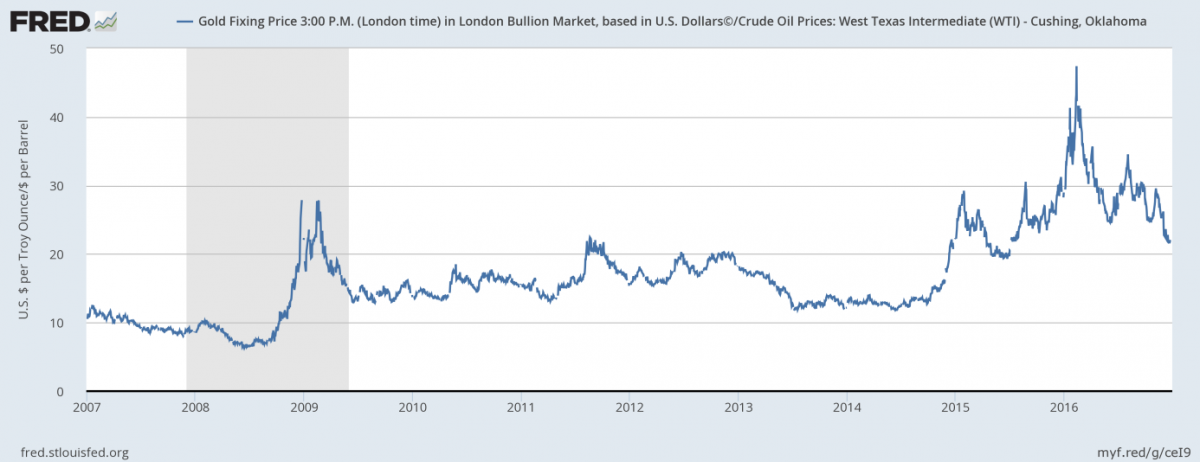What Factors Point To Higher Or Lower Gold Prices?

Some analysts say that gold is oversold. Others claim that gold has not established a bottom yet. Which fundamentals support which outcome?
Sentiment Turns Bearish
The price of gold plunged in the last quarter of 2016. Since the U.S. presidential election, gold prices have dived about 14 percent. Speculators became very negative on gold as the speculative long gold positions declined for a sixth week in a row last week. According to the Commitment of Traders report, long positions dropped from the peak of 315,643 at the beginning of July to 135,232 contracts last week, while short positions increased from 28,722 to 81,321. In consequence, the total speculative net positions decreased from 286,291 to 53,911 contracts. As the chart below shows, money managers cut their position from over 255,000 at the end of September to about 43,000 net long contracts at the end of December. Therefore, the speculative levels are one of the lowest in years, but we have not yet hit the lows observed in December 2015, before the beginning of gold’s price rally . Anyway, sentiment clearly turned from bullish to bearish in the fourth quarter of 2016.
Chart 1: The price of gold (yellow line, right axis, London P.M. fixing) and the net position of money managers (green line, left axis) over the last 12 months.

Is Gold Close To Bottom?
The sentiment towards gold is now bearish. However, the key question is whether the sentiment is bearish enough to establish the bottom and enable gold prices to reverse? Well, the spectacular drop in speculative positions made the gold market much healthier. However, it may be too early to call the bottom as we should see some stabilization in net long positions first. To be clear, the sentiment towards gold is very negative right now. Hence, we could see a short-term reversal sometime in January, especially given that January is often positive for the yellow metal. However, there are no signs of slowing down in gold selling by the money managers. Therefore, we would not be surprised if the price of gold declined well below $1,100, especially if the US dollar continues to rise.
Additionally, the open interest in gold futures is significantly lower than in the summer, which signals that participation in the market is rather anemic. In other words, the current sentiment may be not bearish enough for a reversal to occur. To be sure the further drop in the price of gold may be needed to attract new players to the market.
Moreover, the current negative sentiment may just reflect the bearish fundamental environment. The rise in the real interest rates and the US dollar are important headwinds for the yellow metal. The more hawkish Fed is another big obstacle to rally.
And the decline in the gold-to-oil ratio should also exert downward pressure on the gold prices, as it signals that the global economy is improving. This is because crude oil is a key industrial commodity, while the yellow metal is a safe-haven asset. Therefore, the ratio is a leading indicator of global economic health, which increases during economic distress, decreases when the global economy flourishes. As the chart below shows, the ratio declined from 47 in February to just about 22 in December 2016, indicating reduced worries about the global economy.
Chart 2: Gold-to-oil ratio over the last 10 years.

To sum up, the market sentiment towards gold clearly turned bearish in the second half of 2016. Although it is very negative right now, it may be not be bearish enough. We may be not very far from the bottom. Nonetheless, investors should not be surprised by further declines in gold prices. And remember that picking the bottom is often like catching a falling knife. If you have not mastered advanced contrarian strategies, do not fight the trend (instead, we encourage you to check out our trading services for precious metals investors or at least review our gold trading tips).
Disclaimer: Please note that the aim of the above analysis is to discuss the likely long-term impact of the featured phenomenon on the price of gold and this analysis does not indicate (nor does it aim to do so) whether gold is likely to move higher or lower in the short- or medium-term. In order to determine the latter, many additional factors need to be considered (i.e. sentiment, chart patterns, cycles, indicators, ratios, self-similar patterns and more). Moreover, we are taking them into account (and discussing the short- and medium-term outlook) in our trading alerts.


















